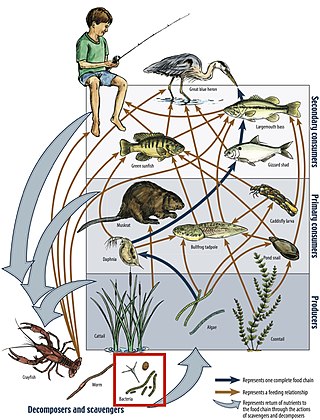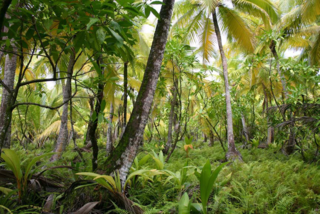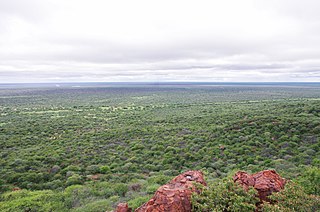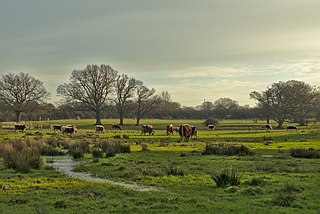Related Research Articles

A herbivore is an animal anatomically and physiologically adapted to eating plant material, for example foliage or marine algae, for the main component of its diet. As a result of their plant diet, herbivorous animals typically have mouthparts adapted to rasping or grinding. Horses and other herbivores have wide flat teeth that are adapted to grinding grass, tree bark, and other tough plant material.

A mycorrhiza is a symbiotic association between a fungus and a plant. The term mycorrhiza refers to the role of the fungus in the plant's rhizosphere, its root system. Mycorrhizae play important roles in plant nutrition, soil biology, and soil chemistry.

A food web is the natural interconnection of food chains and a graphical representation of what-eats-what in an ecological community. Ecologists can broadly define all life forms as either autotrophs or heterotrophs, based on their trophic levels, the position that they occupy in the food web. To maintain their bodies, grow, develop, and to reproduce, autotrophs produce organic matter from inorganic substances, including both minerals and gases such as carbon dioxide. These chemical reactions require energy, which mainly comes from the Sun and largely by photosynthesis, although a very small amount comes from bioelectrogenesis in wetlands, and mineral electron donors in hydrothermal vents and hot springs. These trophic levels are not binary, but form a gradient that includes complete autotrophs, which obtain their sole source of carbon from the atmosphere, mixotrophs, which are autotrophic organisms that partially obtain organic matter from sources other than the atmosphere, and complete heterotrophs that must feed to obtain organic matter.

A grassland is an area where the vegetation is dominated by grasses (Poaceae). However, sedge (Cyperaceae) and rush (Juncaceae) can also be found along with variable proportions of legumes, like clover, and other herbs. Grasslands occur naturally on all continents except Antarctica and are found in most ecoregions of the Earth. Furthermore, grasslands are one of the largest biomes on earth and dominate the landscape worldwide. There are different types of grasslands: natural grasslands, semi-natural grasslands, and agricultural grasslands. They cover 31–69% of the Earth's land area.

Energy flow is the flow of energy through living things within an ecosystem. All living organisms can be organized into producers and consumers, and those producers and consumers can further be organized into a food chain. Each of the levels within the food chain is a trophic level. In order to more efficiently show the quantity of organisms at each trophic level, these food chains are then organized into trophic pyramids. The arrows in the food chain show that the energy flow is unidirectional, with the head of an arrow indicating the direction of energy flow; energy is lost as heat at each step along the way.

Plant defense against herbivory or host-plant resistance (HPR) is a range of adaptations evolved by plants which improve their survival and reproduction by reducing the impact of herbivores. Plants can sense being touched, and they can use several strategies to defend against damage caused by herbivores. Many plants produce secondary metabolites, known as allelochemicals, that influence the behavior, growth, or survival of herbivores. These chemical defenses can act as repellents or toxins to herbivores or reduce plant digestibility. Another defensive strategy of plants is changing their attractiveness. To prevent overconsumption by large herbivores, plants alter their appearance by changing their size or quality, reducing the rate at which they are consumed.
Trophic cascades are powerful indirect interactions that can control entire ecosystems, occurring when a trophic level in a food web is suppressed. For example, a top-down cascade will occur if predators are effective enough in predation to reduce the abundance, or alter the behavior of their prey, thereby releasing the next lower trophic level from predation.

Plant ecology is a subdiscipline of ecology that studies the distribution and abundance of plants, the effects of environmental factors upon the abundance of plants, and the interactions among plants and between plants and other organisms. Examples of these are the distribution of temperate deciduous forests in North America, the effects of drought or flooding upon plant survival, and competition among desert plants for water, or effects of herds of grazing animals upon the composition of grasslands.
In ecology, the term productivity refers to the rate of generation of biomass in an ecosystem, usually expressed in units of mass per volume per unit of time, such as grams per square metre per day. The unit of mass can relate to dry matter or to the mass of generated carbon. The productivity of autotrophs, such as plants, is called primary productivity, while the productivity of heterotrophs, such as animals, is called secondary productivity.
In ecology, a priority effect refers to the impact that a particular species can have on community development as a result of its prior arrival at a site. There are two basic types of priority effects: inhibitory and facilitative. An inhibitory priority effect occurs when a species that arrives first at a site negatively affects a species that arrives later by reducing the availability of space or resources. In contrast, a facilitative priority effect occurs when a species that arrives first at a site alters abiotic or biotic conditions in ways that positively affect a species that arrives later. Inhibitory priority effects have been documented more frequently than facilitative priority effects. Studies indicate that both abiotic and biotic factors can affect the strength of priority effects. Priority effects are a central and pervasive element of ecological community development that have significant implications for natural systems and ecological restoration efforts.

A mycorrhizal network is an underground network found in forests and other plant communities, created by the hyphae of mycorrhizal fungi joining with plant roots. This network connects individual plants together. Mycorrhizal relationships are most commonly mutualistic, with both partners benefiting, but can be commensal or parasitic, and a single partnership may change between any of the three types of symbiosis at different times.
Suzanne Mary Prober is an Australian botanist and ecologist.
Size-asymmetric competition refers to situations in which larger individuals exploit disproportionately greater amounts of resources when competing with smaller individuals. This type of competition is common among plants but also exists among animals. Size-asymmetric competition usually results from large individuals monopolizing the resource by "pre-emption". i.e. exploiting the resource before smaller individuals are able to obtain it. Size-asymmetric competition has major effects on population structure and diversity within ecological communities.

Woody plant encroachment is a natural phenomenon characterised by the increase in density of woody plants, bushes and shrubs, at the expense of the herbaceous layer, grasses and forbs. It predominantly occurs in grasslands, savannas and woodlands and can cause biome shifts from open grasslands and savannas to closed woodlands. The term bush encroachment refers to the expansion of native plants and not the spread of alien invasive species. It is thus defined by plant density, not species. Bush encroachment is often considered an ecological regime shift and can be a symptom of land degradation. The phenomenon is observed across different ecosystems and with different characteristics and intensities globally.
Erika S. Zavaleta is an American professor of ecology and evolutionary biology at the University of California, Santa Cruz. Zavaleta is recognized for her research focusing on topics including plant community ecology, conservation practices for terrestrial ecosystems, and impacts of community dynamics on ecosystem functions.
Herbivores' effects on plant diversity vary across environmental changes. Herbivores could increase plant diversity or decrease plant diversity. Loss of plant diversity due to climate change can also affect herbivore and plant community relationships

James Benjamin Grace, aka James Grace, Jim Grace is a senior research scientist with the U.S. Geological Survey. Formerly he was a professor at Louisiana State University and associate professor at the University of Arkansas. He is an ecologist whose work has focused on science methodology, particularly the use of structural equation modeling as a means of investigating complex, system-level hypotheses.

The wood-pasture hypothesis is a scientific hypothesis positing that open and semi-open pastures and wood-pastures formed the predominant type of landscape in post-glacial temperate Europe, rather than the common belief of primeval forests. The hypothesis proposes that such a landscape would be formed and maintained by large wild herbivores. Although others, including landscape ecologist Oliver Rackham, had previously expressed similar ideas, it was the Dutch researcher Frans Vera, who, in his 2000 book Grazing Ecology and Forest History, first developed a comprehensive framework for such ideas and formulated them into a theorem. Vera's proposals, although highly controversial, came at a time when the role grazers played in woodlands was increasingly being reconsidered, and are credited for ushering in a period of increased reassessment and interdisciplinary research in European conservation theory and practice. Although Vera largely focused his research on the European situation, his findings could also be applied to other temperate ecological regions worldwide, especially the broadleaved ones.
Carol Anne Blanchette is research biologist at the University of California, Santa Barbara who is known for her work on marine intertidal zones and the biomechanics of marine organisms.
Janneke Hille Ris Lambers is a professor of Plant Ecology at ETH Zurich in Switzerland since 2020 and an Affiliate Full Professor at University of Washington in the United States.
References
- ↑ "Elizabeth Borer | College of Biological Sciences". cbs.umn.edu. Retrieved 2019-03-08.
- 1 2 3 ORCID. "Elizabeth Borer (0000-0003-2259-5853)". orcid.org. Retrieved 2021-08-11.
- ↑ "Elizabeth T. Borer dissertation". search.library.ucsb.edu. Archived from the original on 2021-08-11. Retrieved 2021-08-11.
- ↑ "NCEAS | National Center for Ecological Analysis and Synthesis". www.nceas.ucsb.edu. Retrieved 2019-03-08.
- ↑ "Welcome to the Nutrient Network! | Nutrient Network: A Global Research Cooperative". www.nutnet.org. Retrieved 2019-03-08.
- ↑ "UMN researchers lead global study on human impact on ecosystems". The Minnesota Daily. Retrieved 2019-05-29.
- ↑ "Past Lancaster Awardees | Graduate Division". www.graddiv.ucsb.edu. Retrieved 2021-08-11.
- ↑ "Fellows Directory | Leopold Leadership Program". leopoldleadership.stanford.edu. Retrieved 2019-03-10.
- ↑ "Faculty Leadership Council". Institute on the Environment. Retrieved 2019-03-10.
- ↑ "Ecological Society of America announces 2019 Fellows". Ecological Society of America. Retrieved 2019-09-27.
- ↑ "2020 Fellows | American Association for the Advancement of Science". www.aaas.org. Retrieved 2020-12-20.
- ↑ Pell, Bruce; E. Kendig, Amy; T. Borer, Elizabeth; Kuang, Yang (2019). "Modeling nutrient and disease dynamics in a plant-pathogen system". Mathematical Biosciences and Engineering. 16 (1): 234–264. doi: 10.3934/mbe.2019013 . ISSN 1547-1063. PMID 30674119.
- ↑ Kohli, Mayank; Borer, Elizabeth T.; Kinkel, Linda; Seabloom, Eric W. (2019-02-12). "Stability of grassland production is robust to changes in the consumer food web". Ecology Letters. 22 (4): 707–716. Bibcode:2019EcolL..22..707K. doi:10.1111/ele.13232. ISSN 1461-023X. PMID 30747475. S2CID 73444992.
- ↑ "Biodiversity change is uncoupled from species richness trends: Consequences for conservation and monitoring". Applied Soil Ecology. 61: 169–170. 2012. doi:10.1016/j.apsoil.2012.08.006. ISSN 0929-1393.
- ↑ Mortensen, Brent; Danielson, Brent; Harpole, W. Stanley; Alberti, Juan; Arnillas, Carlos Alberto; Biederman, Lori; Borer, Elizabeth T.; Cadotte, Marc W.; Dwyer, John M. (2017-07-17). "Herbivores safeguard plant diversity by reducing variability in dominance". Journal of Ecology. 106 (1): 101–112. doi: 10.1111/1365-2745.12821 . ISSN 0022-0477.
- ↑ Anderson, T. Michael; Griffith, Daniel M.; Grace, James B.; Lind, Eric M.; Adler, Peter B.; Biederman, Lori A.; Blumenthal, Dana M.; Daleo, Pedro; Firn, Jennifer (2018-03-31). "Herbivory and eutrophication mediate grassland plant nutrient responses across a global climatic gradient". Ecology. 99 (4): 822–831. Bibcode:2018Ecol...99..822A. doi: 10.1002/ecy.2175 . hdl: 2263/65003 . ISSN 0012-9658. PMID 29603733.
- ↑ Borer, Elizabeth T.; Seabloom, Eric W.; Mitchell, Charles E.; Cronin, James P. (2013-10-15). "Multiple nutrients and herbivores interact to govern diversity, productivity, composition, and infection in a successional grassland". Oikos. 123 (2): 214–224. doi:10.1111/j.1600-0706.2013.00680.x. ISSN 0030-1299.
- ↑ Borer, Elizabeth T.; Seabloom, Eric W.; Tilman, David (2012). Novotny, Vojtech (ed.). "Plant diversity controls arthropod biomass and temporal stability". Ecology Letters. 15 (12): 1457–1464. Bibcode:2012EcolL..15.1457B. doi:10.1111/ele.12006. PMID 23020194.
- ↑ Borer, Elizabeth T.; Antonovics, Janis; Kinkel, Linda L.; Hudson, Peter J.; Daszak, Peter; Ferrari, Matthew J.; Garrett, Karen A.; Parrish, Colin R.; Read, Andrew F. (2011). "Bridging Taxonomic and Disciplinary Divides in Infectious Disease". EcoHealth. 8 (3): 261–267. doi:10.1007/s10393-011-0718-6. ISSN 1612-9202. PMC 3292718 . PMID 22086388.
- ↑ Chisholm, Ryan (2011-11-21). "Faculty of 1000 evaluation for Productivity is a poor predictor of plant species richness". doi: 10.3410/f.13335979.14742068 .
{{cite journal}}: Cite journal requires|journal=(help) - ↑ Borer, E. T.; Mitchell, C. E.; Power, A. G.; Seabloom, E. W. (2009-01-06). "Consumers indirectly increase infection risk in grassland food webs". Proceedings of the National Academy of Sciences. 106 (2): 503–506. Bibcode:2009PNAS..106..503B. doi: 10.1073/pnas.0808778106 . ISSN 0027-8424. PMC 2626732 . PMID 19126681.
- ↑ Borer, Elizabeth T.; Briggs, Cheryl J.; Holt, Robert D. (2007). "Predators, Parasitoids, and Pathogens: A Cross-Cutting Examination of Intraguild Predation Theory". Ecology. 88 (11): 2681–2688. Bibcode:2007Ecol...88.2681B. doi:10.1890/06-1707.1. ISSN 0012-9658. PMID 18051634.
- ↑ Borer, E. T.; Hosseini, P. R.; Seabloom, E. W.; Dobson, A. P. (2007-03-19). "Pathogen-induced reversal of native dominance in a grassland community". Proceedings of the National Academy of Sciences. 104 (13): 5473–5478. Bibcode:2007PNAS..104.5473B. doi: 10.1073/pnas.0608573104 . ISSN 0027-8424. PMC 1838473 . PMID 17372211.
- ↑ Borer, E. T.; Seabloom, E. W.; Shurin, J. B.; Anderson, K. E.; Blanchette, C. A.; Broitman, B.; Cooper, S. D.; Halpern, B. S. (2005). "What Determines the Strength of a Trophic Cascade?". Ecology. 86 (2): 528–537. Bibcode:2005Ecol...86..528B. doi:10.1890/03-0816. ISSN 0012-9658.